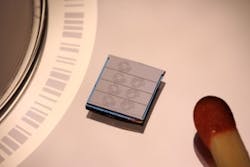Miniature SiN frequency-comb microresonator leads to 1.44 Tbit/s data transmission over 300 km
Researchers at Karlsruhe Institute of Technology (KIT; Karlsruhe, Germany) and the Swiss École Polytechnique Fédérale de Lausanne (EPFL) have transmitted 1.44 Tbit/s over 300 km of fiber using an optical frequency comb light source; they did this by carefully adjusting pump conditions for low phase noise, producing an extremely spectrally pure comb that allowed them to reach very high data rates by using an advanced modulation format.1
Single laser, simpler WDM
One overwhelming potential advantage of using a frequency comb for wavelength-division multiplexing (WDM) approaches is that a frequency comb requires just one laser, while a standard WDM setup requires as many lasers as their are different wavelengths; not only is it hard to work with all these lasers for standard WDM, but it is hard to keep their wavelengths all stabilized with respect to each other. In a frequency comb, the many wavelengths are automatically stable in relation to each other.
In their joint experiment, the KIT and EPFL researchers showed that integrated-optical frequency comb sources with large line spacings can be realized on photonic chips (the spectral lines in conventional frequency combs are normally too close to each other to use for data communications). For this purpose, they use an optical microresonator made of silicon nitride (SiN), into which laser light is coupled via a waveguide and stored for a relatively long period of time.
“Due to the high light intensity in the resonator, the so-called Kerr effect can be exploited to produce a multitude of spectral lines from a single continuous-wave laser beam, hence forming a frequency comb,” says Jörg Pfeifle, who performed the transmission experiment at KIT. This method of generating Kerr frequency combs was discovered by Tobias Kippenberg of EPFL in 2007. Kerr combs are characterized by a large optical bandwidth and can feature line spacings that perfectly meet the requirements of data transmission.
“We are just at the beginning,” says Christian Koos, one of the researchers. “In the experiment presented, we only use 20 lines of the frequency comb. This may certainly be increased. New experiments are planned.”
Source: http://www.kit.edu/visit/pi_2014_14958.php
REFERENCE:
1. Joerg Pfeifle et al., Nature Photonics (2014); doi: 10.1038/nphoton.2014.57.

John Wallace | Senior Technical Editor (1998-2022)
John Wallace was with Laser Focus World for nearly 25 years, retiring in late June 2022. He obtained a bachelor's degree in mechanical engineering and physics at Rutgers University and a master's in optical engineering at the University of Rochester. Before becoming an editor, John worked as an engineer at RCA, Exxon, Eastman Kodak, and GCA Corporation.
